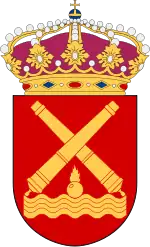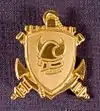Swedish Amphibious Corps
The Amphibious Corps (Swedish: Amfibiekåren, Amf) is the coastal defence arm of the Swedish Navy. Until 2000 it was known as the Coastal Artillery (Swedish: Kustartilleriet), but the name was changed to reflect its different role in a post-Cold War world, where its amphibious special operations arm, Kustjägarna, has grown in significance while its coastal batteries have been decommissioned.
| Amphibious Corps | |
|---|---|
| Amfibiekåren | |
 Coat of arms of the Amphibious Corps. | |
| Founded | 1 July 2000 |
| Country | |
| Branch | Swedish Navy |
| Role | Coastal defense Amphibious warfare |
| Part of | Swedish Navy |
| Motto(s) |
|
| March | "För kustartilleriet" (Åke Dohlin)[1] |
| Engagements | War in Afghanistan EUFOR Tchad/RCA EUNAVFOR |
| Insignia | |
| Cap badge |  |
Organization
The 1st Marine Regiment (Amf 1) is the main combat unit of the Amphibious Corps. With its anti-ship missiles, controllable mines and coastal rangers, as well as marine infantry units, it can exercise control in littoral areas. The Regiment is primarily based at Berga Naval Base near Stockholm. Also based in Gothenburg, is the Marine component of the 13th Security Battalion. In addition, the 1st Marine Regiment is also responsible for training three Home Guard battalions, one of whom is based on Gotland. These are the:
- 1st Marine Regiment (Amf 1)[2]
- 2nd Amphibious Battalion
- HQ Company
- 202nd Coastal Ranger Company
- 204th Rifle Company
- 205th Rifle Company
- 206th Rifle Company
- Support Company
- 17th Amphibious Patrol Boat Company - the company also has anti-submarine warfare capable units based in Gothenburg.
- VBSS troop
- 28th Home Guards Battalion Roslagen
- 29th Home Guards Battalion Södertörn
- 132nd Naval Security Company
Ranks and insignia
Since 2019 the ranks and insignia of the Swedish Amphibious Corps are as follows:[3][4]
- Officers
| Equivalent NATO code | OF-10 | OF-9 | OF-8 | OF-7 | OF-6 | OF-5 | OF-4 | OF-3 | OF-2 | OF-1 | OF(D) and student officer | |||||||||||||||||||||||||
|---|---|---|---|---|---|---|---|---|---|---|---|---|---|---|---|---|---|---|---|---|---|---|---|---|---|---|---|---|---|---|---|---|---|---|---|---|
| No equivalent |  |
 |
 |
 |
 |
 |
 |
 |
 |
 |
 | |||||||||||||||||||||||||
| General | Generallöjtnant | Generalmajor | Brigadgeneral | Överste | Överstelöjtnant | Major | Kapten | Löjtnant | Fänrik | Kadett | ||||||||||||||||||||||||||
- Other ranks
| Equivalent NATO code | OR-9 | OR-8 | OR-7 | OR-6 | OR-5 | OR-4 | OR-3 | OR-2 | OR-1 | |||||||||||||||||||||||||||||||||
|---|---|---|---|---|---|---|---|---|---|---|---|---|---|---|---|---|---|---|---|---|---|---|---|---|---|---|---|---|---|---|---|---|---|---|---|---|---|---|---|---|---|---|
 |
 |
 |
 |
 |
 |
 |
 |
 |
 |
 |
| |||||||||||||||||||||||||||||||
| Regementsförvaltare | Förvaltare | Fanjunkare | Översergeant | Sergeant | Överfurir | Furir | Korpral | Vicekorpral | Menig 4 | Menig 3 | ||||||||||||||||||||||||||||||||
Heraldry and traditions
The coat of arms of the Swedish Amphibious Corps since 2000. It was previously used by the Swedish Coastal Artillery 1979–2000 and the Coastal Artillery Center (Kustartillericentrum, KAC) 1995–1997. Blazon: "Gules, two gunbarrels of older pattern in saltire above a flaming grenade and waves, all or".[5]
See also
 United States - Marine Corps of the United States
United States - Marine Corps of the United States Finland – Nylands Brigade
Finland – Nylands Brigade United Kingdom – Royal Marines
United Kingdom – Royal Marines Netherlands – Netherlands Marine Corps
Netherlands – Netherlands Marine Corps Germany – Seebattalion
Germany – Seebattalion Italy – San Marco Marine Brigade
Italy – San Marco Marine Brigade Spain – Spanish Navy Marines
Spain – Spanish Navy Marines
References
Notes
- Sandberg 2007, p. 198
- https://corporalfrisk.com/2018/06/10/the-swedish-wartime-army/
- "Försvarsmaktens föreskrifter om personaltjänst. 27 november 2019." Försvarets författningssamling. FFS 2019:6, 2 § 8, 14.
- "Nya gradbeteckningar införs." Försvarsmakten. Retrieved 2020-05-20.
- Braunstein 2006, p. 52
Print
- Braunstein, Christian (2006). Heraldiska vapen inom det svenska försvaret [Heraldry of the Swedish Armed Forces] (PDF). Skrift / Statens försvarshistoriska museer, 1101-7023 ; 9 (in Swedish). Stockholm: Statens försvarshistoriska museer. ISBN 91-971584-9-6. SELIBR 10099224.CS1 maint: ref=harv (link)
- Sandberg, Bo (2007). Försvarets marscher och signaler förr och nu: marscher antagna av svenska militära förband, skolor och staber samt igenkännings-, tjänstgörings- och exercissignaler (in Swedish) (New ed.). Stockholm: Militärmusiksamfundet med Svenskt marscharkiv. ISBN 978-91-631-8699-8. SELIBR 10413065.CS1 maint: ref=harv (link)
External links
| Wikimedia Commons has media related to Swedish Amphibious Corps. |
- Official website (in Swedish)
- Official website (in English)


